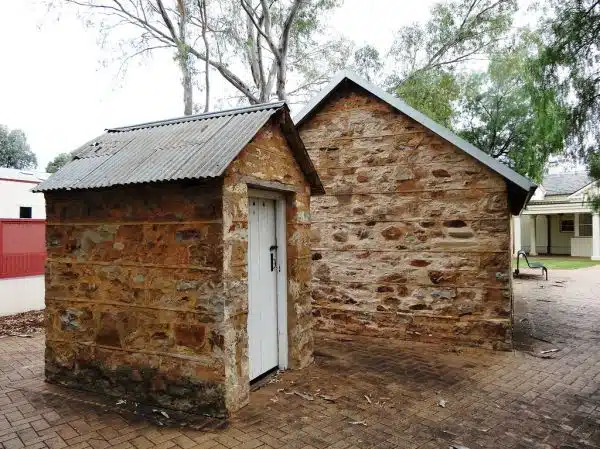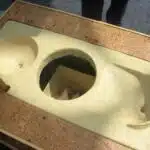As a homeowner, it’s important to keep your bathroom in pristine condition. However, the tight space behind your toilet can often be overlooked when it comes to painting and cleaning. Whether you’re looking to refresh the look of your bathroom or preparing your home for sale, knowing how to paint behind a toilet is an essential skill that every homeowner should have.
In this article, we will provide step-by-step instructions on how to paint behind a toilet, including tips and tricks for achieving a flawless finish. From choosing the right tools and materials to prepping the area and applying paint correctly, we will guide you through the entire process. By following these guidelines, you’ll be able to transform your bathroom into a stunning sanctuary that both you and your guests can enjoy.
Gathering The Tools And Materials You’ll Need
To successfully paint behind a toilet, it’s essential to gather the right tools and materials. Two crucial components are choosing the right brush and selecting the right primer. The brush you select should have a good angle for getting into tight spaces, such as behind the toilet bowl. Additionally, consider using a brush with synthetic bristles because they work well with water-based paints and are easy to clean.
When selecting your primer, choose one that is specifically designed for bathroom use. This type of primer will help prevent mold and mildew growth in high-moisture areas. A mold-resistant primer will also help your paint stick better to surfaces like tile or porcelain.
It’s important to note that before beginning any painting project, you should clear the area around the toilet completely. Move everything out of the way so that you have an unobstructed view of the wall behind the toilet. Once everything is cleared away, it’s time to start preparing your space for painting.
Clearing The Area Around The Toilet
Before painting behind your toilet, it is important to clear the area around it. This involves removing any obstacles that may hamper your ability to paint behind the toilet effectively. Obstacles include mats, rugs, trash cans, and other items that may be in the way.
To ensure a clean and sanitary environment before painting, it is also crucial to sanitize the area around the toilet thoroughly. Use a disinfectant cleaner to wipe down the surfaces surrounding the toilet, including the tank, base, and floor. Pay special attention to areas that are prone to collecting dust and grime.
By clearing obstacles and sanitizing the area around your toilet before painting, you can create a clean canvas for your paint job. The next step in this process involves preparing the wall for painting by sanding it down and filling in any holes or cracks. This will ensure a smooth surface for your paint application and ultimately lead to a more professional-looking finished product.
Preparing The Wall For Painting
- Before painting behind a toilet, it is important to properly clean the wall to ensure the paint adheres to the surface.
- After cleaning, a primer may be necessary to create a smooth and even surface for the paint to adhere to.
- Primers can help mask any flaws or discoloration in the wall and can also help paint adhere to glossy surfaces.
- It is important to use the right primer in order to ensure that the paint will properly adhere to the wall and last for a long time.
Cleaning The Wall
When it comes to painting behind a toilet, preparing the wall is an important step that should not be overlooked. Before starting with the actual painting process, it is essential to clean the wall surface thoroughly. Cleaning techniques may vary depending on the type of paint and wall material. However, a common mistake that many people make is skipping this step or not cleaning the wall properly.
One effective way of cleaning the wall behind a toilet is by using a mixture of warm water and mild detergent. First, remove any dust or debris from the surface using a dry cloth or vacuum cleaner. Then, dampen a sponge or soft cloth in the cleaning solution and gently scrub the wall in circular motions. Be careful not to use too much water as it can damage the wall surface. After washing, rinse off any soap residue using clean water and let it dry completely before proceeding with painting.
Another common mistake when cleaning walls is using harsh chemicals or abrasive tools such as steel wool or scrub pads. These can scratch or damage the surface and create an uneven base for painting. Instead, opt for gentle cleaning solutions and soft materials such as microfiber cloths or sponges. By taking care in preparing your bathroom walls for painting, you can ensure that your finished results look professional and last longer.
Remember that proper preparation is key to achieving excellent results when painting behind your toilet. Take time to clean your bathroom walls carefully before applying paint. Avoid making mistakes such as using harsh chemicals or failing to rinse off soap residue thoroughly. With these tips in mind, you’ll be able to achieve a smooth and even finish that will last for years to come!
Priming The Wall
To achieve a smooth and even finish when painting behind your toilet, proper preparation is crucial. One essential step in preparing the wall for painting is priming it. Priming helps to create an even base for the paint to adhere to and ensures that the color appears true to its intended shade.
There are several types of primer available, and choosing the right one depends on factors such as the type of wall material, paint type, and desired finish. For example, if you’re painting over a surface with stains or discoloration, a stain-blocking primer can help prevent these imperfections from showing through the new paint. If you’re using a water-based paint, a water-based primer would be best.
When priming the wall behind your toilet, there are some best practices you should follow. First, make sure that the surface is clean and dry before applying any primer. Using a clean cloth or sponge and mild detergent solution can effectively remove any dirt or debris. Next, apply the primer evenly using a brush or roller. Allow ample drying time between coats as specified by the manufacturer’s instructions before proceeding with painting. By following these tips, you can ensure that your bathroom walls have an even base for excellent results when painting behind your toilet.
Choosing The Right Type Of Paint
Painting can be a daunting task, especially when it comes to painting in hard-to-reach areas like behind a toilet. However, with the right type of paint, this job can be made much easier. It’s important to choose a paint that is durable and long-lasting, as well as one that will adhere well to the surface you are painting.
When selecting paint for your bathroom, there are several paint finish options to consider. Matte finishes provide a non-reflective surface and are great for hiding imperfections. Satin finishes have a slight sheen and are easy to clean, making them ideal for high-traffic areas like bathrooms. Semi-gloss and gloss finishes have an even greater sheen and are highly durable, but they may highlight any surface imperfections.
Another important consideration when choosing the right type of paint is color combinations. A well-chosen color scheme can transform your bathroom into a relaxing retreat or an energizing space. Lighter colors create an open and airy feeling, while darker colors can add drama and sophistication. Experiment with different color combinations to find the perfect match for your style and preferences.
Transitioning into selecting the right color for your bathroom, it’s important to consider factors such as lighting, size of the room, and existing fixtures before making your final decision. By taking these factors into account along with your personal style preferences, you can ensure that you select the perfect color for your bathroom that will enhance its overall look and feel.
Selecting The Right Color For Your Bathroom
After choosing the right type of paint, it’s time to select the perfect color for your bathroom. Color psychology plays a significant role in choosing the right color for your bathroom. For instance, blue is known to have a calming effect that can make you feel relaxed while yellow can create an energizing atmosphere.
Trending bathroom colors change every year, so it’s essential to keep up with the latest trends when selecting a color for your bathroom. In 2021, earthy tones such as beige and brown are becoming increasingly popular as they provide a warm and inviting ambiance. If you want to add some pops of color to your bathroom, shades of green or even pink can work well if incorporated correctly.
When selecting a color for your bathroom, it’s important to consider how it will coordinate with other elements in the room such as tiles and fixtures. You should also think about how much natural light enters the space as this can affect how the color appears on the walls. Ultimately, choose a color that reflects your personal style and makes you feel comfortable and happy in your own space.
As you move towards mixing your paint, remember that careful preparation is key to achieving excellent results. Mixing paint requires precision and attention to detail; thus, it is crucial that you follow instructions carefully. Also, ensure that you have all necessary materials ready before starting the process. With these tips in mind, you can confidently mix your paint and get started on transforming your bathroom into a beautiful oasis!
Mixing Your Paint
Did you know that 85% of homeowners choose to paint their homes at some point? With so many color options available, it’s no wonder painting is a popular home improvement project. However, before you start painting behind your toilet, it’s important to know how to mix your paint properly.
Mixing tips can vary depending on the type of paint you’re using. Generally, it’s important to stir your paint thoroughly before use. If the paint has been sitting for a while or has separated, pour it into a separate container and mix gently with a stirring stick. Avoid shaking the container vigorously as this can create air bubbles and affect the quality of your finish.
When it comes to choosing colors for your bathroom, consider the overall aesthetic you want to achieve. Neutral tones such as beige or gray are popular choices for creating a calming atmosphere while brighter colors like blue or green can add energy and vibrancy. Don’t forget about sheen options too – semi-gloss finishes are durable and easy to clean in high-moisture areas like bathrooms.
Now that you’ve mixed your paint and chosen your color options, it’s time to prepare for application by protecting surfaces with painter’s tape. This will help ensure clean lines and protect surrounding areas from accidental drips or splatters. Keep reading for our tips on applying painter’s tape effectively.
Applying Painter’s Tape To Protect Surfaces
Prior to painting, preparation of the surface is essential for achieving desired results. This includes ensuring the surface is clean and free of dust, dirt, and grime.
Painter’s tape can be used to protect areas that should not be painted. It is important to apply the tape correctly, pressing it firmly against the surface and ensuring the edges are properly sealed.
When painting behind a toilet, it is important to apply painter’s tape along the edges of the toilet bowl and along the floor where the toilet meets the wall.
Additionally, painter’s tape should be applied along the edges of the floor tiles, baseboards, and any other areas that should remain unpainted.
Preparing The Surface
Pre painting cleaning is a crucial step to ensure that the paint adheres properly to the surface. Before applying painter’s tape behind the toilet, make sure to clean the area thoroughly with soap and water. Use a scrub brush or sponge to remove any dirt, grime or mildew that may have accumulated over time. Once cleaned, use a dry cloth to wipe down the surface.
To prepare the surface for painting, sanding is essential. Sanding creates a rough surface for better paint adhesion and helps remove any imperfections or bumps on the wall. For areas behind the toilet, use a fine-grit sandpaper to avoid damaging any pipes or fixtures. Make sure to wear a mask while sanding to prevent inhaling dust particles.
After prepping and cleaning the surface, apply painter’s tape around all surfaces that need protection from paint drips or splatters. Use a high-quality painter’s tape that is designed for delicate surfaces and can be removed without leaving residue or damaging the walls. Apply it carefully along edges and corners of fixtures such as faucets and pipes, ensuring there are no gaps in coverage. This will help you achieve clean lines once you start painting and also save time on cleanup after painting is complete.
Applying Tape
Now that the surface has been prepped and cleaned, it’s time to apply painter’s tape to protect surfaces from paint drips or splatters. Using different tapes can make a big difference in achieving clean lines and avoiding paint bleed through. A high-quality painter’s tape that is designed for delicate surfaces should be used, ensuring that it can be removed without leaving residue or damaging walls.
When applying painter’s tape, it is important to take your time and apply it carefully along edges and corners of fixtures such as faucets and pipes. This will ensure there are no gaps in coverage and the tape provides maximum protection. Avoid stretching the tape too much, as this can cause it to lose its adhesive properties.
For areas with curves or uneven surfaces, use a flexible tape that can conform to these shapes without creasing or wrinkling. When painting over the taped area, press down firmly on the edges of the tape to prevent any paint from bleeding through. Overall, using painter’s tape correctly can save time on cleanup after painting is complete while also helping achieve professional-looking results.
Starting With The Edges And Corners
When painting behind a toilet, it is essential to use the right painting technique to ensure that you get an even finish. Before starting, make sure you have all the necessary tools like a paintbrush, roller, drop cloth, and painter’s tape. Once you’ve got everything you need, start by painting the edges and corners of the wall.
To avoid mistakes while painting, it is crucial to pay attention to details. Take your time when working around tight spaces like behind the toilet. Use painter’s tape to protect areas that you don’t want to paint accidentally. Also, avoid applying too much pressure on your brush or roller as this can leave unsightly marks on your walls.
Remember that preparation is key when it comes to achieving a professional-looking finish. Clean your walls thoroughly before painting and allow them to dry completely. You can also sand down any rough spots or bumps to create an even surface for your paint.
- Use a small brush for hard-to-reach areas.
- Apply two coats of paint for better coverage.
- Experiment with different color schemes to match your bathroom décor.
Next up, we will discuss using a brush to paint areas around the toilet without accidentally touching it or making a mess.
Using A Brush To Paint Areas Around The Toilet
As you paint behind the toilet, it’s easy to feel like a contortionist with a brush. The tight space makes it difficult to maneuver and reach every nook and cranny. However, with the right techniques, you can make this task a breeze.
Toilet brush techniques come in handy when painting areas around the toilet. Use a small, angled brush to get into tight corners and crevices. Dip the bristles into paint and then tap off any excess before applying it to the wall. This technique ensures that you don’t create drips or runs while painting.
Painting tight spaces requires patience and precision. Slowly build up your coverage by applying thin coats of paint. You may need to use multiple layers to achieve a seamless finish. Don’t rush the process as this will lead to mistakes and uneven coverage.
Now that you’ve tackled the tricky spots around the toilet using toilet brush techniques, it’s time to move onto larger areas. In the next section, we’ll discuss how to use a roller for covering large surfaces quickly and efficiently. With these tips, you’ll be able to tackle any painting project with ease!
Using A Roller To Cover Large Areas
- Before beginning, the wall needs to be prepped by cleaning it and repairing any cracks or holes.
- Using a good quality roller, start rolling the paint in a “W” motion and work in small sections.
- When painting around a toilet, tilt the roller away from the toilet to avoid splashing and dripping.
- Allow the paint to dry completely before adding a second coat and then let the area air out before returning the toilet to its original position.
Preparing The Wall
Before painting behind a toilet, it is essential to prepare the wall by cleaning and removing any dirt or debris. Pre painting cleaning is crucial as it ensures that the paint adheres well to the surface and lasts longer. Use a sponge or cloth with mild detergent to clean the area thoroughly. Rinse with water and let dry before proceeding.
Wall texture considerations are also important when preparing to paint behind a toilet. If the wall has a textured finish, it may require additional preparation to ensure proper coverage of the paint. Sanding or priming may be necessary, depending on the type of texture present. It is best to consult with a professional if you are unsure about how to handle textured walls.
In conclusion, preparing the wall before painting behind a toilet is crucial for achieving a flawless finish. Pre painting cleaning and wall texture considerations are two significant factors that should not be overlooked. By taking these steps, you can ensure that your paint job looks great and lasts for years to come.
Rolling On The Paint
Moving on to the next step in painting a bathroom wall, using a roller to cover large areas is an efficient way to achieve a smooth and even coat of paint. While using paintbrushes is also an option, rollers are better suited for larger surfaces such as walls and ceilings. Rollers come in various sizes and materials, making them versatile tools for any painting project.
When using a roller, it is essential to choose the appropriate nap (length of fibers) for your surface. A shorter nap is suitable for smoother surfaces such as drywall, while a longer nap is better suited for textured or uneven walls. Additionally, it is crucial to apply the right amount of pressure when rolling on the paint to ensure proper coverage without leaving behind streaks or bubbles. Experimenting with different techniques can help you find what works best for your specific project.
While rollers are the go-to tool for covering large areas quickly and efficiently, there are possible alternatives worth considering. For instance, spray guns can provide flawless finishes but require more elaborate preparation and cleanup procedures. Additionally, paint pads offer an alternative method that can be less messy than rollers while still providing even coverage. As with all tools and techniques used in home improvement projects, finding what works best for your specific needs takes some experimentation and practice.
Applying Multiple Coats For Optimal Results
When painting a bathroom, it’s important to apply multiple coats of paint for optimal results. The number of coats needed depends on the type and quality of paint being used, as well as the color and surface being painted. It’s best to follow the manufacturer’s instructions for the specific type of paint you are using.
One key factor in achieving a professional-looking finish is allowing sufficient drying time between each coat of paint. This can vary depending on humidity and temperature, but generally, it’s recommended to wait at least 24 hours before applying another coat. Rushing this step can result in an uneven finish or even cause the paint to peel over time.
To ensure the best possible outcome, it’s also important to use high-quality brushes or rollers when applying paint. This will help the paint go on more smoothly and evenly, reducing the need for additional coats. Additionally, using a primer before painting can help improve adhesion and coverage, which may result in fewer coats needed overall.
- When applying multiple coats:
- Use light pressure with your brush or roller
- This helps prevent streaks or bubbles from forming
- Allow each coat to dry completely before adding another
- This ensures that each layer is properly bonded to the surface
In order to achieve a flawless finish when painting behind a toilet, taking your time with multiple coats is crucial. Remember to allow for proper drying time between each coat and use high-quality materials for best results. Once all coats have been applied, move onto the next step: letting the paint dry completely.
Letting The Paint Dry Completely
Applying multiple coats of paint is crucial in achieving optimal results. However, before the paint application process, one should prepare the area to be painted thoroughly. In this case, painting behind a toilet can be quite challenging, but it can still be done efficiently with the right materials and techniques.
To prevent smudging and avoid accidental contact when painting behind a toilet, one must start by removing any objects or fixtures that may obstruct the painting process. Then, cover the toilet bowl with plastic wrap or a garbage bag to protect it from any accidental splatters. Next, use painter’s tape to seal off the edges around the toilet to prevent any paint from seeping through.
Once everything is set up, begin painting using long and even strokes while keeping your hand as steady as possible. It would also be helpful to use a small brush for tight spaces and corners. When finished, let the paint dry completely before removing the painter’s tape.
Table:
| Tips for Painting Behind a Toilet | | — | — | | Remove all objects/furniture | | Cover toilet bowl with plastic wrap | | Seal edges with painter’s tape | | Use long and even strokes | | Let paint dry completely before removing tape |
When it comes to home improvement projects like painting, attention to detail is crucial in achieving professional-looking results. By following these tips and techniques on how to paint behind a toilet with ease while preventing smudging and avoiding accidental contact, you can make your bathroom look brand new without any hassle. After letting the paint dry completely, you may proceed with removing the painter’s tape carefully to reveal clean lines around your newly painted wall.
Removing Painter’s Tape
Did you know that using painter’s tape can save you up to 40% of your painting time? This handy tool not only helps prevent paint bleed but also ensures clean lines for a professional-looking finish. However, removing painter’s tape can be tricky and if done improperly, it can ruin all the hard work you put into painting behind your toilet. Follow these tips and tricks to remove painter’s tape without damaging your newly painted surface.
- Gently pull the tape at a 45-degree angle: Tugging on the tape too aggressively can cause paint to peel off with it. To avoid this, start by pulling the tape slowly and gently at a 45-degree angle away from the painted surface.
- Use a utility knife: If you notice that the tape is still stuck after gently pulling it, grab a utility knife and run it along the edge of the tape. This will help loosen any adhesive residue that may be left behind.
- Apply heat: Heat can help soften the adhesive and make it easier to remove. Use a hairdryer or heat gun on low setting and apply gentle heat to the area where the tape is located.
Preventing paint bleed is crucial in achieving a professional-looking result when painting behind your toilet. To ensure clean lines, follow these techniques:
- Press down firmly on edges of painter’s tape to seal them against surfaces
- Use less paint on roller or brush when working close to edge of taped area
- Remove painter’s tape before paint dries completely
Now that you have successfully removed painter’s tape and ensured clean lines in your painting job, it’s time to clean up the area around your toilet before admiring your handiwork.
Cleaning Up The Area
When painting behind a toilet, it is crucial to clean up the area before and after painting. This ensures that you have a smooth surface for painting and also prevents any dirt or debris from sticking to the fresh paint. Prior to starting your painting project, gather all necessary cleaning tools such as a vacuum, broom, dustpan, and cleaning solution.
Safety precautions are essential when cleaning up the area behind a toilet. Always wear gloves and protective eyewear to prevent any germs or chemicals from coming into contact with your skin or eyes. Make sure to keep the area well ventilated by opening windows or using a fan, especially if you are using strong cleaning solutions.
After finishing your painting project, take the time to clean up the area thoroughly. Sweep or vacuum any dust or debris that may have accumulated during the painting process. Use an appropriate cleaning solution to wipe down surfaces such as walls and floors in order to remove any residue left behind by paint brushes or rollers. By following these safety precautions and properly cleaning up the area, you can ensure that your bathroom remains hygienic and safe for use.
Now that you have cleaned up your work space, it’s time to admire your handiwork! But before doing so, it’s important to let the paint dry completely. Avoid touching or moving anything in the room until at least 24 hours have passed since applying the final coat of paint. This will ensure that your new paint job is free from smudges or imperfections caused by premature handling of items in the room. Once everything has dried properly, you can finally relax and enjoy your newly painted bathroom!
Admiring Your Handiwork!
Cleaning up the area behind your toilet can be quite a challenging task. However, painting it is an entirely different ball game. It requires a lot of patience, skill, and attention to detail. But with the right approach, you can paint behind your toilet like a pro.
The first step in painting behind your toilet is choosing complementary colors that will blend well with your bathroom’s existing color scheme. You can either match the color or go for a contrasting shade that will make your toilet stand out. When selecting colors, consider the lighting in your bathroom as it can alter how colors appear.
Using different painting techniques can also help you achieve the desired effect behind your toilet. You can opt for stenciling, sponge painting, or even textured finishes to add some dimension and depth to space. Remember to use high-quality paint and brushes for best results.
- Cover the toilet: Use plastic wrap to cover the entire surface of the toilet so that no paint drips on it.
- Protect other surfaces: Use painter’s tape to mask off any areas around the toilet that you don’t want to get painted.
- Take your time: Painting behind a toilet may take longer than expected because of its awkward positioning. Be patient and take breaks if necessary.
Admiring Your Handiwork! Now that you’ve completed painting behind your toilet using complementary colors and different painting techniques, it’s time to sit back and admire your handiwork! With proper planning and execution, this task has now become an achievement worth showing off to family and friends. Enjoy!
Conclusion
Painting behind a toilet may seem like a daunting task, but with the right tools and techniques, it can be done easily. Before beginning, gather the necessary materials such as painter’s tape, paintbrushes, rollers and trays. Clear the area around the toilet to avoid any accidental spills or splatters. Next, prepare the wall by sanding and cleaning it thoroughly.
Choosing the right type of paint is crucial for a successful painting job behind a toilet. Opt for a mildew-resistant paint that will withstand moisture and humidity in bathrooms. Once you have selected your desired color, apply two coats of paint using long strokes to ensure even coverage. Let the paint dry completely before removing painter’s tape and cleaning up the area.
In conclusion, painting behind a toilet may require some extra effort but with these simple steps, it can be accomplished with ease. Remember to take precautionary measures such as clearing the area and using mildew-resistant paint for longevity. With a fresh coat of paint on your bathroom walls, you’ll be able to admire your handiwork in no time! So why wait? Get started on transforming your bathroom today!
Image Credits
- “Salisbury. Old outhouses or toilets behind the Police Station and Courthouse.” by denisbin (featured)





























